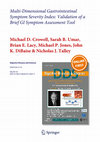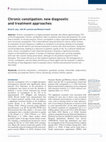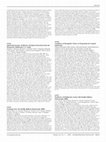Papers by Michael D Crowell, Ph.D., MACG, AGAF

Gut, Jan 10, 2014
Peripancreatic fat necrosis occurs frequently in necrotising pancreatitis. Distinguishing markers... more Peripancreatic fat necrosis occurs frequently in necrotising pancreatitis. Distinguishing markers from mediators of severe acute pancreatitis (SAP) is important since targeting mediators may improve outcomes. We evaluated potential agents in human pancreatic necrotic collections (NCs), pseudocysts (PCs) and pancreatic cystic neoplasms and used pancreatic acini, peripheral blood mononuclear cells (PBMC) and an acute pancreatitis (AP) model to determine SAP mediators. We measured acinar and PBMC injury induced by agents increased in NCs and PCs. Outcomes of caerulein pancreatitis were studied in lean rats coadministered interleukin (IL)-1β and keratinocyte chemoattractant/growth-regulated oncogene, triolein alone or with the lipase inhibitor orlistat. NCs had higher fatty acids, IL-8 and IL-1β versus other fluids. Lipolysis of unsaturated triglyceride and resulting unsaturated fatty acids (UFA) oleic and linoleic acids induced necro-apoptosis at less than half the concentration in NCs...

Few instruments have been developed and validated for the evaluation of multi-dimensional GI symp... more Few instruments have been developed and validated for the evaluation of multi-dimensional GI symptoms. The Gastrointestinal Symptoms Severity Index (GISSI), a multi-dimensional, self-report instrument, was designed as a brief measure of the frequency, severity, and bothersomeness of individual GI and pelvic floor/ urogynecologic symptoms. Aim To report the psychometric properties of the GISSI subscales, including factorial structure, validity, and internal consistency. Methods The GISSI included 32 items that assessed upper and lower GI symptoms and seven items related to pelvic floor/urogynecologic symptoms. A total of 934 patients presenting for upper and lower GI complaints completed the questionnaire between January 2013 and December 2013. The sample was randomly split into derivation (n = 466) and validation datasets (n = 468). A non-patient sample of 200 was collected separately. Results Exploratory factor analysis supported a six-factor model for the derivation sample that accounted for 69.3 % of the total variance. The six GI symptom clusters were labeled as constipation/difficult defecation (five items), abdominal pain/discomfort (four items), dyspepsia (four items), diarrhea/anal incontinence (four items), GERD/ chest symptoms (four items), and nausea/vomiting (two items). Inclusion of additional items related to female pelvic floor/urogynecologic symptoms resulted in a separate factor. Confirmatory factor analysis of the validation dataset supported the a priori hypothesized six-factor measurement model (V 2 (428) = 1462.98; P \ 0.001; GFI = .88; RMSEA = .051). Conclusion The GISSI demonstrated good to excellent psychometric properties and provided multi-dimensional scaling of prominent GI symptom clusters. Further validation may provide an efficient, valid, and reliable measure of patient-reported clinical outcomes.

The Rome IV Diagnostic Questionnaires were developed to screen for functional gastrointestinal di... more The Rome IV Diagnostic Questionnaires were developed to screen for functional gastrointestinal disorders, serve as inclusion criteria in clinical trials, and support epidemio-logic surveys. Separate questionnaires were developed for adults, children and adolescents, and infants and toddlers. For the adult questionnaire, we first surveyed 1162 adults without gastrointestinal disorders, and recommended the 90 th percentile symptom frequency as the threshold for defining what is abnormal. Diagnostic questions were formulated and verified with clinical experts using a recursive process. The diagnostic sensitivity of the questionnaire was tested in 843 patients from 9 gastroenter-ology clinics, with a focus on clinical diagnoses of irritable bowel syndrome (IBS), functional constipation (FC), and functional dyspepsia (FD). Sensitivity was 62.7% for IBS, 54.7% for FD, and 32.2% for FC. Specificity, assessed in a population sample of 5931 adults, was 97.1% for IBS, 93.3% for FD, and 93.6% for FC. Excess overlap among IBS, FC, and FD was a major contributor to reduced diagnostic sensitivity, and when overlap of IBS with FC was permitted, sensitivity for FC diagnosis increased to 73.2%. All questions were understandable to at least 90% of individuals, and Rome IV diagnoses were reproducible in three-fourths of patients after 1 month. Validation of the pediatric questionnaires is ongoing.

Clinical gastroenterology and hepatology : the official clinical practice journal of the American Gastroenterological Association, Jan 5, 2016
We assessed peristaltic reserve using multiple rapid swallows (MRS) during esophageal high-resolu... more We assessed peristaltic reserve using multiple rapid swallows (MRS) during esophageal high-resolution manometry (HRM) of 111 patients with systemic sclerosis (89 female; ages 42-64 years). We performed a retrospective analysis of HRM studies that included MRS in patients with systemic sclerosis, performed at 2 tertiary referral centers, and compared data with those from 18 healthy volunteers (controls). HRM findings were analyzed according to the Chicago Classification to provide an esophageal motility diagnosis. Response to MRS was evaluated for presence of contraction and for augmentation, defined as distal contractile integral after MRS greater than the median distal contractile integral of 10 supine swallows. Esophageal motility diagnoses included 41% with absent contractility, 31% with normal motility, 23% with ineffective esophageal motility, and 5% that met the criteria for other esophageal motility disorders. Contraction (37%) and peristaltic augmentation (18%) following MRS...

Gastroenterology, 1998
The 5-HT1A receptor agonist buspirone is an anxiolytic drug which has been reported to be benefic... more The 5-HT1A receptor agonist buspirone is an anxiolytic drug which has been reported to be beneficial in the treatment of the irritable bowel syndrome (Friedman 1991). It has been assumed that the central anxiolytic effect was responsible for the therapeutic benefit in these patients. However, the effect of 5-HT1A receptor activation on the tone and the visceral sensitivity of the rectum have not been studied. Aim: To study the effect of buspirone on rectal tone and sensitivity using a barostat. Methods: In 9 healthy subjects (7 males, age 21-30 years), an electronic barostat was used to assess the effect of buspirone on rectal tone and on perception of isobaric rectal distensions. After rectal cleansing with a water enema, a flaccid spherical barostat balloon (max. volume = 500 ml) was introduced into the rectum. After an accommodation period of 30 minutes, graded isobaric distensions (increments of 2 mm Hg of 2 min duration) were performed until the subjects reported discomfort. Volume and pressure changes were recorded and perception was scored by a questionnaire (score 0-6, l=threshold sensation, 4=desire to defecate, 5=discomfort). Subsequently, the pressure was set at Operating Pressure (OP, defined as the lowest pressure needed to reach an intraballoon volume of >30 ml) +2 mm Hg during one hour, with administration of buspirone 10 mg orally after 30 minutes. Afterwards, graded distensions were repeated. Results (mean -+ SEM) were compared by paired t-test and by two-way ANOVA. Results: During baseline isobaric rectal distensions, threshold sensation was reached at a distending pressure of 9.4-+ 1.1 mm Hg and a volume of 96.9 -+ 22.6 ml. Desire to defecate was reached at a distending pressure of 19.9-+ 1.7 mm Hg and a volume of 236 -+41 ml, and discomfort at a distending pressure of 24.4 -+ 1.8 mm Hg and a volume of 307 -+ 40 ml. After buspirone, the thresholds for perception (11.8 -+ 6.4 mm Hg and 181 -+ 44 ml, p < 0.05) or desire to defecate (23.7 -+ 1.8 mm Hg and 296 -+ 31 ml, p < 0.05) were significantly higher. Discomfort thresholds were not altered by buspirone (27.1 -+ 1.8 mm Hg and 316 -+ 30 ml). Administration of buspirone shifted the pressure-volume curve towards significantly higher volumes for the same distending pressures (p < 0.01, ANOVA). The slope of the pressurevolume relation (rectal compliance) was not significantly altered (13.8 -+ 1.8 vs 12.1 -+ 1.3 ml/mm Hg, NS). Conclusions; Administration of buspirone 10 mg orally causes a relaxation of the rectum in man. This is accompanied by a decrease of rectal sensitivity for first perception and desire to defecate during rectal distension. The effects of buspirone on the rectum are likely to contribute to the observed benefit in the treatment of the irritable bowel syndrome. Our findings suggest that 5-HTIA receptor agonists could have therapeutic potential in the treatment of the irritable bowel syndrome. • G3047 CHRONIC ABDOMINAL PAIN: A MULTIVARIATE ANALYSIS OF PSYCHOLOGICAL DISTRESS. C_rowell MD. The M. M.

Chronic constipation is a highly prevalent disorder that affects approximately 15% of the US popu... more Chronic constipation is a highly prevalent disorder that affects approximately 15% of the US population. Chronic constipation refers to patients who have had symptoms for more than 6 months. In clinical practice, chronic constipation is often used interchangeably with the term functional constipation. This is best defined using the Rome III criteria, which involves an evaluation of stool frequency in addition to symptoms of straining, feelings of incomplete evacuation, and the need to use manual maneuvers to assist with stool evacuation. Symptoms can be burdensome, leading to a reduction in patients' quality of life. As a national healthcare issue, chronic constipation is also important because it imposes a significant economic impact on the healthcare system. A number of treatment options are currently available, both over-the-counter and by prescription, although not all patients respond to these therapies. This review will focus on new medical treatment options for the management of chronic constipation, and the safety and efficacy of these agents will be reviewed. In addition, the efficacy of new diagnostic tests to evaluate colonic motility and anorectal function are described.

Gastroenterology, Jan 13, 2016
The Rome IV Diagnostic Questionnaires were developed to screen for functional gastrointestinal di... more The Rome IV Diagnostic Questionnaires were developed to screen for functional gastrointestinal disorders (FGIDs), serve as inclusion criteria in clinical trials, and support epidemiological surveys. Separate questionnaires were developed for adults, children/adolescents, and infants/toddlers. For the adult questionnaire, we first surveyed 1,162 adults without gastrointestinal disorders, and recommended the 90(th) percentile symptom frequency as the threshold for defining what is abnormal. Diagnostic questions were formulated and verified with clinical experts using a recursive process. The diagnostic sensitivity of the questionnaire was tested in 843 patients from 9 gastroenterology clinics, with a focus on clinical diagnoses of irritable bowel syndrome (IBS), functional constipation (FC), and functional dyspepsia (FD). Sensitivity was 62.7% for IBS, 54.7% for FD, and 32.2% for FC. Specificity, assessed in a population sample of 5,931 adults, was 97.1% for IBS, 93.3% for FD, and 93....

Gastroenterology and Hepatology, Jul 1, 2013
Fecal incontinence (FI) is a devastating disorder that is more prevalent than previously realized... more Fecal incontinence (FI) is a devastating disorder that is more prevalent than previously realized. FI is the involuntary loss of stool. Many factors contribute to the pathophysiology of FI, including advanced age, bowel irregularity, parity, and obesity. A detailed history and focused rectal examination are important to making the diagnosis and determining contributing causes. Although multiple diagnostic studies are available to assess the cause of FI, specific guidelines that delineate when testing should be done do not exist. Clinicians must weigh the risk, benefit, and burden of testing against the need for empiric treatment. All types of FI are initially managed in the same way, which includes lifestyle modification to reduce bowel derangements, improved access to toileting, and initiation of a bulking regimen to improve stool consistency. If initial conservative management fails, pharmaco-logic agents, biofeedback, or surgery may be indicated.

World Journal of Gastrointestinal Pharmacology and Therapeutics, 2016
To evaluate the efficacy of lower esophageal sphincter (LES)-electrical stimulation therapy (EST)... more To evaluate the efficacy of lower esophageal sphincter (LES)-electrical stimulation therapy (EST) in a subgroup of patients that reported only partial response to proton pump inhibitors (PPIs) therapy, compared to a group of patient with complete response. Bipolar stitch electrodes were laparoscopically placed in the LES and connected to an implantable pulse generator (EndoStim BV, the Hague, the Netherlands), placed subcutaneously in the anterior abdominal wall. Stimulation at 20 Hz, 215 μsec, 3-8 mAmp in 30 min sessions was delivered starting on day 1 post-implant. Patients were evaluated using gastroesophageal reflux disease (GERD)-HRQL, symptom diaries; esophageal pH and esophageal manometry before and up to 24 mo after therapy and results were compared between partial and complete responders. Twenty-three patients with GERD on LES-EST were enrolled and received continuous per-protocol stimulation through 12 mo and 21 patients completed 24 mo of therapy. Of the 23 patients, 16 (8 male, mean age 52.1 ± 12 years) had incomplete response to PPIs prior to LES-EST, while 7 patients (5 male, mean age 52.7 ± 4.7) had complete response to PPIs. In the sub-group with incomplete response to PPIs, median (IQR) composite GERD-HRQL score improved significantly from 9.5 (9.0-10.0) at baseline on-PPI and 24.0 (20.8-26.3) at baseline off-PPI to 2.5 (0.0-4.0) at 12-mo and 0.0 (0.0-2.5) at 24-mo follow-up (P &amp;amp;amp;amp;amp;amp;amp;amp;amp;amp;amp;amp;amp;amp;amp;amp;amp;amp;amp;amp;amp;amp;amp;amp;amp;amp;amp;amp;amp;amp;amp;amp;amp;amp;amp;amp;amp;amp;amp;amp;amp;amp;amp;amp;amp;amp;amp;amp;amp;amp;amp;amp;amp;amp;amp;amp;amp;amp;amp;amp;amp;amp;amp;amp;amp;amp;amp;amp;amp;amp;lt; 0.05 compared to on-and off-PPI at baseline). Median (IQR) % 24-h esophageal pH &amp;amp;amp;amp;amp;amp;amp;amp;amp;amp;amp;amp;amp;amp;amp;amp;amp;amp;amp;amp;amp;amp;amp;amp;amp;amp;amp;amp;amp;amp;amp;amp;amp;amp;amp;amp;amp;amp;amp;amp;amp;amp;amp;amp;amp;amp;amp;amp;amp;amp;amp;amp;amp;amp;amp;amp;amp;amp;amp;amp;amp;amp;amp;amp;amp;amp;amp;amp;amp;amp;lt; 4.0 at baseline in this sub-group improved significantly from 9.8% (7.8-11.5) at baseline to 3.0% (1.9-6.3) at 12 mo (P &amp;amp;amp;amp;amp;amp;amp;amp;amp;amp;amp;amp;amp;amp;amp;amp;amp;amp;amp;amp;amp;amp;amp;amp;amp;amp;amp;amp;amp;amp;amp;amp;amp;amp;amp;amp;amp;amp;amp;amp;amp;amp;amp;amp;amp;amp;amp;amp;amp;amp;amp;amp;amp;amp;amp;amp;amp;amp;amp;amp;amp;amp;amp;amp;amp;amp;amp;amp;amp;amp;lt; 0.001) and 4.6% (2.0-5.8) at 24 mo follow-up (P &amp;amp;amp;amp;amp;amp;amp;amp;amp;amp;amp;amp;amp;amp;amp;amp;amp;amp;amp;amp;amp;amp;amp;amp;amp;amp;amp;amp;amp;amp;amp;amp;amp;amp;amp;amp;amp;amp;amp;amp;amp;amp;amp;amp;amp;amp;amp;amp;amp;amp;amp;amp;amp;amp;amp;amp;amp;amp;amp;amp;amp;amp;amp;amp;amp;amp;amp;amp;amp;amp;lt; 0.01). At their 24-mo follow-up, 9/11 patients in this sub-group were completely free of PPI use. These results were comparable to the sub-group that reported complete response to PPI therapy at baseline. No unanticipated implantation or stimulation-related adverse events, or any untoward sensation due to stimulation were reported in either group and LES-EST was safely tolerated by both groups. LES-EST is safe and effective in controlling symptoms and esophageal acid exposure in GERD patients with incomplete response to PPIs. These results were comparable to those observed PPI responders.

Journal of Clinical Gastroenterology, May 1, 2009
Patients&amp;amp;amp;amp;amp;amp;amp;amp;amp;amp;amp;amp;amp;amp;amp;amp;amp;amp;amp;amp;amp;... more Patients&amp;amp;amp;amp;amp;amp;amp;amp;amp;amp;amp;amp;amp;amp;amp;amp;amp;amp;amp;amp;amp;amp;amp;amp;#39; knowledge and perceptions of functional dyspepsia (FD) may affect illness behavior and healthcare utilization. To develop, validate, and administer a survey instrument to assess symptoms, knowledge, and fears in FD patients. A 66-item questionnaire was generated. Items assessed domains of etiology, diagnosis, natural history, and fears. Face and content validity were established through expert review and a patient focus group. After validation, questionnaires were mailed to a separate group of FD patients. Responses were analyzed using scales and means. For survey validation, 66 of 80 patients (83%) returned both surveys. Internal consistency was good for most scale level measures (alpha=0.50 to 0.90). Reliability coefficients were good for measures of symptom assessment (intraclass correlation coefficient=0.75 to 0.89) and consulting behaviors (intraclass correlation coefficient=0.76 to 0.89). After survey validation, an additional 223 (62.8%) questionnaires were returned. Misperceptions were noted in the domains of etiology, diagnosis, treatment and risks of FD. Forty-eight percent of the respondents believed FD increases the risk of developing an ulcer and 32% believed there was an increased risk of developing stomach or colon cancer. This novel questionnaire demonstrated good validity and reliability in FD patients, and identified significant misperceptions about the etiology, evaluation, treatment, and natural history of FD.

Digestive diseases and sciences, Jan 5, 2015
Few instruments have been developed and validated for the evaluation of multi-dimensional GI symp... more Few instruments have been developed and validated for the evaluation of multi-dimensional GI symptoms. The Gastrointestinal Symptoms Severity Index (GISSI), a multi-dimensional, self-report instrument, was designed as a brief measure of the frequency, severity, and bothersomeness of individual GI and pelvic floor/urogynecologic symptoms. To report the psychometric properties of the GISSI subscales, including factorial structure, validity, and internal consistency. The GISSI included 32 items that assessed upper and lower GI symptoms and seven items related to pelvic floor/urogynecologic symptoms. A total of 934 patients presenting for upper and lower GI complaints completed the questionnaire between January 2013 and December 2013. The sample was randomly split into derivation (n = 466) and validation datasets (n = 468). A non-patient sample of 200 was collected separately. Exploratory factor analysis supported a six-factor model for the derivation sample that accounted for 69.3 % of...

Gut, 1997
Chronic constipation is a highly prevalent disorder that affects approximately 15% of the US popu... more Chronic constipation is a highly prevalent disorder that affects approximately 15% of the US population. Chronic constipation refers to patients who have had symptoms for more than 6 months. In clinical practice, chronic constipation is often used interchangeably with the term functional constipation. This is best defined using the Rome III criteria, which involves an evaluation of stool frequency in addition to symptoms of straining, feelings of incomplete evacuation, and the need to use manual maneuvers to assist with stool evacuation. Symptoms can be burdensome, leading to a reduction in patients' quality of life. As a national healthcare issue, chronic constipation is also important because it imposes a significant economic impact on the healthcare system. A number of treatment options are currently available, both over-the-counter and by prescription, although not all patients respond to these therapies. This review will focus on new medical treatment options for the management of chronic constipation, and the safety and efficacy of these agents will be reviewed. In addition, the efficacy of new diagnostic tests to evaluate colonic motility and anorectal function are described.

Gastrointestinal Endoscopy, 2009
to ½ (31.2%), and O ½ (15.6%), the rates of CR were 94.1%, 40.0%, 0.0%. In terms of endoscopic re... more to ½ (31.2%), and O ½ (15.6%), the rates of CR were 94.1%, 40.0%, 0.0%. In terms of endoscopic resection technique, submucosal injection was a statistically significant positive predictor of CR (p Z 0.0121), while APC use was a negative predictor of CR (p Z 0.0178). The only significant predictor of acute bleeding was use of piecemeal resection (p Z 0.0470). There were no perforations. Conclusions: Successful endoscopic resection of sporadic non-ampullary duodenal adenomas is more likely in younger patients and in those whose lesions involve up to 25% of the luminal circumference. The extent of luminal circumference that the lesion involves was the strongest predictor of successful eradication. Successful endoscopic eradication is not likely when lesions extend beyond 50% of the luminal circumference. Submucosal injection is an effective endoscopic technique for enhancing CR. While APC was a negative predictor for CR and acute bleeding occurred more commonly when piecemeal resection was performed, these were likely surrogate markers for increased lesion size. S1514 Spiral Enteroscopy: Predictors of Depth of Insertion from the Prospective Multicenter U.S. Study
Uploads
Papers by Michael D Crowell, Ph.D., MACG, AGAF